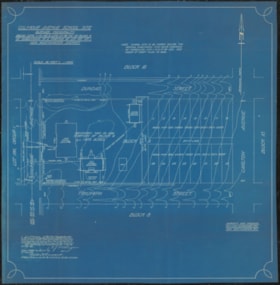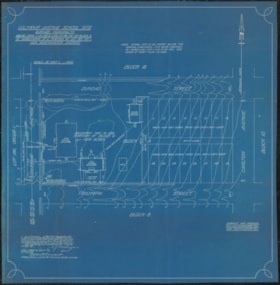Narrow Results By
Central Park Entrance Gate
https://search.heritageburnaby.ca/link/landmark544
- Repository
- Burnaby Heritage Planning
- Description
- The Central Park Entrance Gate is the ceremonial entrance to Burnaby’s historic Central Park from Kingsway, and consists of two massive stone pillars, approximately 7.5 metres high and 1.8 metres square, adjacent gate posts and a low flanking stone wall that curves into the park to the east.
- Associated Dates
- 1913
- Formal Recognition
- Heritage Designation, Community Heritage Register
- Street View URL
- Google Maps Street View
- Repository
- Burnaby Heritage Planning
- Geographic Access
- Imperial Street
- Associated Dates
- 1913
- Formal Recognition
- Heritage Designation, Community Heritage Register
- Enactment Type
- Bylaw No. 9807
- Enactment Date
- 23/11/1992
- Description
- The Central Park Entrance Gate is the ceremonial entrance to Burnaby’s historic Central Park from Kingsway, and consists of two massive stone pillars, approximately 7.5 metres high and 1.8 metres square, adjacent gate posts and a low flanking stone wall that curves into the park to the east.
- Heritage Value
- The Central Park Entrance Gate is significant as a ceremonial entry to a major park, for its connection with the early history of the British Columbia Electric Railway (BCER) and as an important design by an accomplished British Columbian architect. When the original interurban line between Vancouver and New Westminster was constructed in 1891, one of the first stations was located where the tramway crossed the Vancouver-Westminster Road (now Kingsway) within the newly-created Central Park. The interurban line ran through the park on a diagonal right-of-way (the current SkyTrain line, opened in 1986, follows this original alignment). In 1912 an agreement was reached between the successor interurban company, the BCER, and the Central Park Provincial Park Board, to deed additional land for an expanded right-of-way through the Park in exchange for improvements that included the construction of an ornamental stone wall and gate with an iron arch, with an illuminated 'Central Park' sign, adjacent to the interurban station on Kingsway. This was an early and rare example of an electric sign used for a public recreation facility. The Gate is also significant as a surviving early design by Robert Lyon (1879-1963), an Edinburgh-born and trained immigrant who was one of the most accomplished of British Columbia's early architects. After he moved to Vancouver, he was employed by the BCER from 1911 until 1918, and worked on a broad range of projects including some of the grandest and most innovative local industrial structures of the time. The arch was built by the Westminster Ironworks Company, one of the leading firms of its kind in Western Canada, operated by John Reid of New Westminster. The Gate was completed in 1914; in 1968 the decorative ironwork was removed due to corrosion and placed in storage.
- Defining Elements
- Key elements that define the heritage character of the Central Park Entrance Gate include its: - two subtly tapered massive stone pillars, which rise in stages from a larger base to a shaft with random coursed multi-coloured granite with roughly formed grey granite quoins, to a top formed of finely finished grey granite blocks with a coved and bracketed cap - adjacent gate posts with monolithic pyramidal granite caps - low flanking stone wall that curves into the park to the east, constructed of random coursed multi-coloured granite with a river rock triangular cap
- Historic Neighbourhood
- Central Park (Historic Neighbourhood)
- Planning Study Area
- Maywood Area
- Architect
- Robert Lyon
- Builder
- John Reid
- Westminster Iron Works Co.
- Function
- Primary Current--Park Fixture
- Primary Historic--Park Fixture
- Community
- Burnaby
- Cadastral Identifier
- P.I.D. No. 017-767-172 Legal Description: Block B of Lot 2 Except Firstly: Part on Plan 8669 and Secondly: Part on Plan LMP4689 District Lot 151, Group 1, New Westminster District, Plan 3443
- Boundaries
- The property (Central Park) is a municipally-owned park that lies at the western edge of Burnaby, between 49th Avenue to the south, Kingsway to the north, Boundary Road to the west and Patterson Avenue to the east.
- Area
- 853,403.82
- Contributing Resource
- Structure
- Landscape Feature
- Ownership
- Public (local)
- Names
- Lyon, Robert
- Reid, John
- Westminster Iron Works Company
- British Columbia Electric Railway Company
- Central Park Provincial Park Board
- Subjects
- Structures - Fences
- Street Address
- 3883 Imperial Street
- Street View URL
- Google Maps Street View
Images
Gilmour Avenue School site
https://search.heritageburnaby.ca/link/museumdescription11129
- Repository
- Burnaby Village Museum
- Date
- May 27, 1915
- Collection/Fonds
- Ronald G. Scobbie collection
- Description Level
- Item
- Physical Description
- 1 survey plan : blueprint on paper ; 56 x 54 cm
- Scope and Content
- Survey plan of Gilmore Avenue School site. Title on plan reads: "Gilmour Avenue School Site / Burnaby Municipality / Being Lots 1-10 inc. & Lots 27-36 inc. of Block 9 / of Subdivision of a Portion of Lot 187, GP.1 / New Westminster District". "Note. School site is as shown below, the original...am…
- Repository
- Burnaby Village Museum
- Collection/Fonds
- Ronald G. Scobbie collection
- Description Level
- Item
- Physical Description
- 1 survey plan : blueprint on paper ; 56 x 54 cm
- Material Details
- Scale: 40 feet = 1 inch
- Scope and Content
- Survey plan of Gilmore Avenue School site. Title on plan reads: "Gilmour Avenue School Site / Burnaby Municipality / Being Lots 1-10 inc. & Lots 27-36 inc. of Block 9 / of Subdivision of a Portion of Lot 187, GP.1 / New Westminster District". "Note. School site is as shown below, the original...amended" "by cancelling Lots 1-10 & 27-30 inc....order of court filed No.4938".
- History
- The school was named after Hugh B. Gilmour, but an error by a municipal clerk in the Street Naming Bylaw in 1912 (Bylaw Number 135) changed the spelling to "Gilmore" Avenue and the school name was spelled "Gilmore" Avenue School hereafter.
- Creator
- McGugan, Donald Johnston
- Subjects
- Buildings - Schools
- Names
- Gilmore Avenue School
- Responsibility
- Burnett & McGugan, Engineers and Surveyors
- Geographic Access
- Gilmore Avenue
- Accession Code
- BV003.83.8
- Access Restriction
- No restrictions
- Reproduction Restriction
- No known restrictions
- Date
- May 27, 1915
- Media Type
- Cartographic Material
- Historic Neighbourhood
- Vancouver Heights (Historic Neighbourhood)
- Planning Study Area
- Willingdon Heights Area
- Scan Resolution
- 440
- Scan Date
- 22-Dec-2020
- Scale
- 100
- Notes
- Transcribed title taken from plan
- Oath in bottom left corner reads: "I, D.J. McGugan...did superintend the survey", "...completed on the 27th day of May 1915" and noterized by Walter Edmonds" "sworn...29th Day of May 1915"; "Burnett and McGugan. B.C. Land Surveyors Etc. New Westminster. B.C."
- Note in black ink on verso of plan reads: "1782"
Zoomable Images
Gladys Killip subseries
https://search.heritageburnaby.ca/link/archivedescription58418
- Repository
- City of Burnaby Archives
- Date
- 1904-1998
- Collection/Fonds
- Burnaby Historical Society fonds
- Description Level
- Subseries
- Physical Description
- Textual records and graphic material
- Scope and Content
- Subseries consists of papers pertaining to the Killip family, primarily Gladys Killip's personal activism in the municipality of Burnaby and the causes she supported. Subseries also includes photographs of the Burnaby Council of Women taken during Gladys Killip's time as Publicity Co-Chairwoman du…
- Repository
- City of Burnaby Archives
- Date
- 1904-1998
- Collection/Fonds
- Burnaby Historical Society fonds
- Subseries
- Gladys Killip subseries
- Physical Description
- Textual records and graphic material
- Description Level
- Subseries
- Accession Number
- BHS1996-12
- BHS1998-11
- BHS2000-02
- BHS2007-04
- Scope and Content
- Subseries consists of papers pertaining to the Killip family, primarily Gladys Killip's personal activism in the municipality of Burnaby and the causes she supported. Subseries also includes photographs of the Burnaby Council of Women taken during Gladys Killip's time as Publicity Co-Chairwoman during the 1967 Centennial Celebration festivity "100 Years of Progress in Women's Activities, Arts and Crafts" .
- History
- Gladys M. Yeomans married Alfred Charles “Charlie” Killip in St. Andrew’s Wesley United Church in Vancouver on August 16, 1947. They spent their honeymoon together at the Sunset Inn at Qualicum Beach. The Killips lived in the same house in South Burnaby for the greater part of their married lives. Their address began as 729 Marshall, changed to 729 Hazelmere Street in 1951 (due to bylaw 3133) and again to 7763 Hazelmere Street (due to 1958/1959 street re-numbering). The Killips were activists within Burnaby, writing letters to their member of Council when they felt that the citizens of Burnaby were not being treated fairly. An example of this is when they led the protest against Pacific Stage Lines for reducing its service on the Grandview Highway by making fewer stops and by changing its route. Gladys led their delegation to Council in June of 1964. Gladys was also involved in the activities of the Valley View Players and in Burnaby Little Theatre activities. She was part of the cast of “Crime at Blossoms” in 1951 and held a membership card from 1952 to 1959 for the Valley View Players Club. Among other roles, she was one of the principle actors in “You Can’t Take it With You” and “In the Shadow of the Glen” both performed in 1957. Gladys was the Burnaby Council of Women Publicity Co-Chairwoman. In this capacity she helped to organize such events as the "100 Years of Progress in Women's Activities, Arts and Crafts" for the Centennial Celebration in 1967 (the Burnaby Diamond Jubilee). She was also a founding member of the Century Park Museum Association, which created under the auspices of the Burnaby Centennial '71 Committee, to administer Burnaby's Centennial '71 Commemorative Project, Heritage Village. Both Gladys and Charles Killip were active members of the Monarchist League of Canada. Gladys’ hobby started with a small silver spoon commemorating King George VI taking the throne in 1936. Her collection includes items commemorating every Royal from Prince Edward, Queen Victoria's father, to a cup commemorating one of Prince Williams recent birthdays. Gladys opened the Silver Spoon collectors shop in Burnaby in 1974 and operated it until 1980 when she and her husband Charlie retired to Qualicum Beach and opened Chilham Village Antiques and Collectables in 1984. The Killips earned a Silver Badge of Service from the Monarchist League of Canada in 1992 for their significant contribution to the League’s work. As of November 2010, Ms. Gladys Yeomans’ collection of British Royal family memorabilia has grown so large, that she has countless of mugs, spoons, plates, t-shirts and pieces of poetry, filling a room in her basement and upstairs in her home in Vancouver Island, British Columbia.
- Media Type
- Textual Record
- Photograph
- Notes
- Title based on contents of subseries
- PC497, MSS125, MSS081, MSS085



